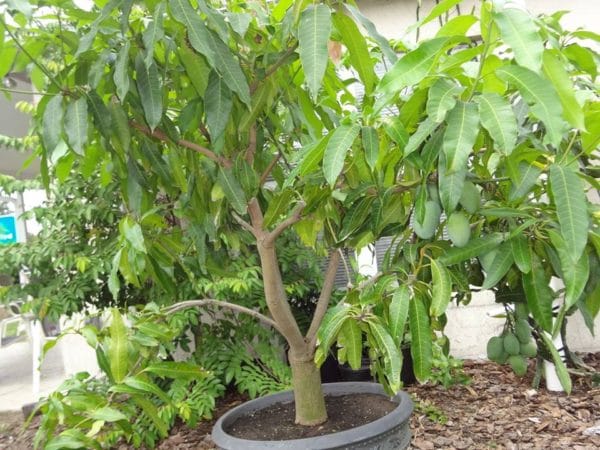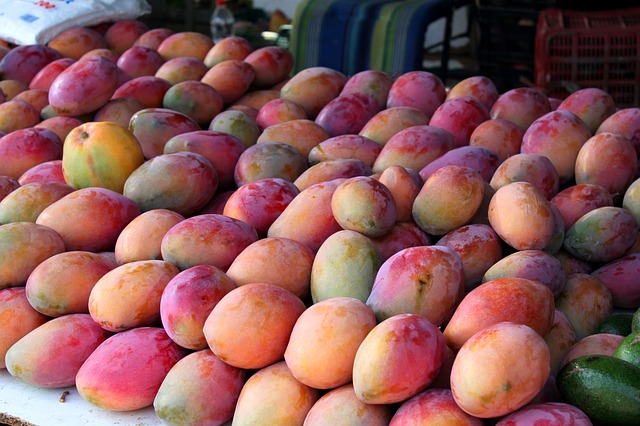Mango Trees in Containers: 15 Best Mango Varieties for Small Spaces

For those of us trying to grow Mango trees outside of the tropics or in marginal climates, growing them in containers is the way to go. Here in the Phoenix, Arizona desert, we’re considered growing zone 9b, which is fringe conditions for growing mangoes.
With some frost protection, mango trees can survive in the ground, but all it takes is one cold winter, and your mango tree can be gone in an instant. Growing mango trees in a container allows you to protect them by moving the Mango tree into a garage, greenhouse, or another warm place as needed.
Growing Mango Trees Outside of the Tropics
By utilizing a container, it allows growers outside of the tropics to have a chance to successfully grow mangoes. Mango trees need warmth throughout the year for growth and fruit production.
In areas with harsh winters, in theory, you’ll be able to grow a mango tree in a container, but if your summers are short, it’s doubtful you’ll get fruit. Mango trees bloom anywhere from Nov-Mar, so it will require light and a greenhouse environment in those climates. Otherwise, if you’re in zones with long summers and light winters, you’ll absolutely be able to get fruit.
RELATED POST: Growing Mango Trees in Hot, Dry Climates
Quick Tips for Growing Mangoes in Containers

Pick the Right Container
It’s important to use a container that isn’t any larger than 2-3 times the size of the root ball, so the tree can be adequately watered. Since you’ll be moving them around, the lighter the better. Plastic or grow bags will be your best bet.
RELATED POST: Should I use Smart Pots (Grow Bags) in Hot Climates
Soil
Use a mix that promotes drainage to prevent root rot and other problems. I use a cactus type mix that contains lava sand. When planting allow for 2-3 inches at the top for adding mulch and compost.
Fertilizing
Since container trees don’t have nutrients readily available, it’s up to you to be consistent with fertilizing. During the growing season, you’ll need to have a consistent feeding regimen.
Hot Climates
If growing in a hot, dry climate like where I reside in the Arizona desert, you’ll want to move your mango tree into an area that gets some afternoon shade during the hottest times of the year.
It’s important when using a black pot to make sure the pot is always shaded or the sun can fry the roots and dry out extremely quick.
Water
In the hotter months, trees in containers dry out quickly, so they will need ample watering. Check out my guide for watering fruit trees in hot climates.
Fungicides
In areas where anthracnose and other fungal diseases are prevalent, it may be necessary to provide periodic applications of copper fungicide. Click here for Liqui-Cop, which is what I use found on Amazon.
Moving the Pot
When you start upping your Mango tree to a 25-gallon pot and larger it gets extremely heavy. You’ll need to utilize a plant dolly, which can be found by clicking here. Putting your planter on wheels is another great option, which can be found by clicking here.
The Best Mango Varieties for Containers or Small Spaces
Here are my 15 varieties to try if you have limited backyard space or are planning to grow in a container:

Julie
This mango is most commonly found in the Caribbean where it rose to prominence. Julie is considered a dwarf tree. This mango is fairly small at about 6-10oz on average. It tends to develop a slight orange blush. The fruit typically ripens from June-August. Julie packs a flavor punch but does contain some fiber.
Fairchild
This mango originated from Panama. It’s considered a condo mango, but still well-acclimated to container culture. The Fairchild mango typically has a yellowish-green skin and ripens in June-July. It’s a fiberless mango with a rich, aromatic flavor.
Dwarf Hawaiian
This mango is reportedly an offspring of Julie and Kent. It produces mangoes early in the season and is typically one of the first varieties to fruit. Dwarf Hawaiian can produce multiple crops throughout the year.
It has a rich flavor, somewhat reminiscent to Julie, but can have a hint of coconut. It usually weighs around 10 oz and has a more round shape with creamy flesh.
Carrie
One of the varieties in my collection, another reported offspring of Julie. Carrie can be difficult to know when to harvest because the skin tends to stay mostly green.
The flesh melts in your mouth and full of complex flavor. It has no fiber and can bruise very easy if mishandled. Another condo mango, but adaptable to a container. It has a compact growth habit. The fruit tends to ripen in June-July at around 12 oz.
Irwin
This mango is one that originated in south Florida and has some Haden lineage. It’s a dwarf tree that works for a container. Irwin can be a heavy producer. The fruit has a beautiful dark red blush. The fruit is fiberless and ripens in June-July.
Nam Doc Mai
This is a classic Asian desert mango. There are a few variations of this variety. Some varieties are more dwarf then the standard Na, Doc Mai, but even that is a naturally smaller tree good for a pot. This sweet, juicy mango has an elongated shape which tends to develop a yellowish skin color.
Pickering
This variety is most widely recognized as one made for a container. Pickering is highly productive at an early age and small size. It can have hints of coconut flavor. The flesh is firm and fiberless ranging from 12-32 oz in size. Its skin appearance tends to be yellowish with some burgundy blush, often with some brown streaking.
Ice Cream
This mangoes origins are from Trinidad and Tobago. It’s considered semi-dwarf and easy to maintain at around 6 feet. The fruit is small at only 5-12 oz. The flesh is fiberless, with a sweet and spicy flavor. It typically ripens in June-July and has a greenish-yellow skin.
Mallika
This is an Indian type with parents of Neelum and Dasheri. One of the favorite Indian dessert type mangoes, condo mango suited for containers. It has some citrus undertones, along with some melon, with a sweet, rich taste that many enjoy. The mango is around 10-16 oz and ripens in June-July.
Cogshall
Another variety dubbed as semi-dwarf, compact, and perfect for container growers. This is an offspring of Haden and originated in Florida. It’s a fiberless mango, that’s sweet, and has a classic mango taste. It’s a colorful mango that has several shades of blush. It’s known to ripen in June-July and is about 10-16oz.
Lancetilla
This mango is said to come from Honduras as a cross between Saigon and Mulgoba. These mangoes can be huge up to 5lbs. The tree is semi-dwarf and can easily be maintained at 10 feet or less. It’s a later variety ripening in August-October. It’s a sweet, fiberless mango, with a reddish blush.
Alampur Baneshan
This variety has origins in India and hails as another fine Indian dessert type mango. It’s best when harvested at a mature green state and left on the counter to fully ripen. The fruit can be overpowering for some and mainly this mango isn’t very common outside of India.
The tree is another condo mango type for container growing. Fruits can average around 16 oz and have an oblong shape. They commonly ripen in June-July.
Graham
Once again, another offspring of Julie that originated from Trinidad. The flavor packs a punch which is rich, sweet, and complex. Fruits can be a bit larger weighing in at 20-26 oz. They ripen from June-August with a yellow skin that occasionally has a slight pink blush. This variety is a bit more vigorous, getting much larger than Julie, but can be maintained at 10 feet.
Rosigold
This mango may have originated in Southeast Asia from the Ono variety. It’s considered a condo mango that has a low growth habit good for containers. The fruit ripens early sometimes as early as March. It’s a fiberless mango, sweet, and aromatic.
It typically has a yellow skin with an orange-red blush. It’s also being used more as a rootstock for its ability to naturally be container grown.
Honey Kiss
It is believed that this variety originated from Gary and Keitt varieties. It’s a compact growing condo mango tree, which bears a heavy crop, usually in clusters. This variety is somewhat of a slow grower which also makes it easier to manage in a container.
Honey Kiss has a deep honey flavor. It’s mainly fiberless with a red blush and yellowish-green skin. It ripens from July-August and fruits weigh in around 8-16 oz.
